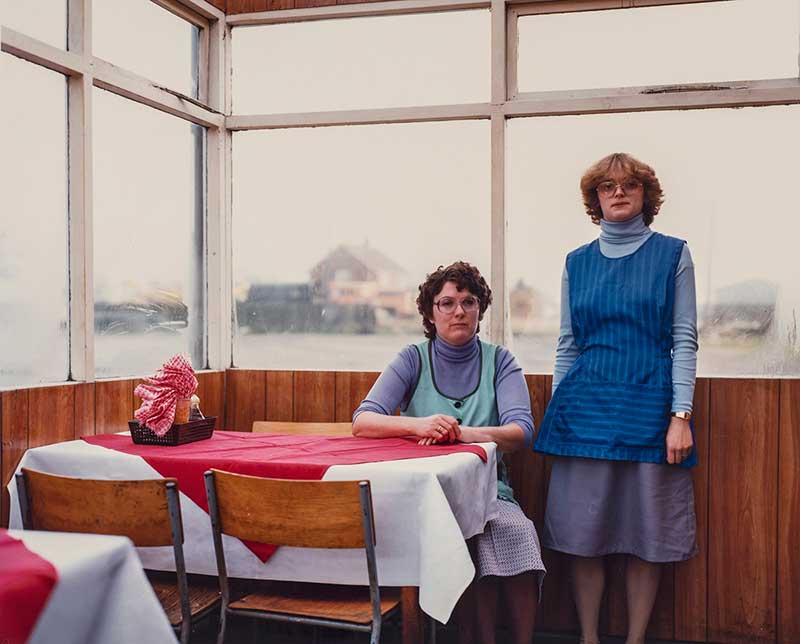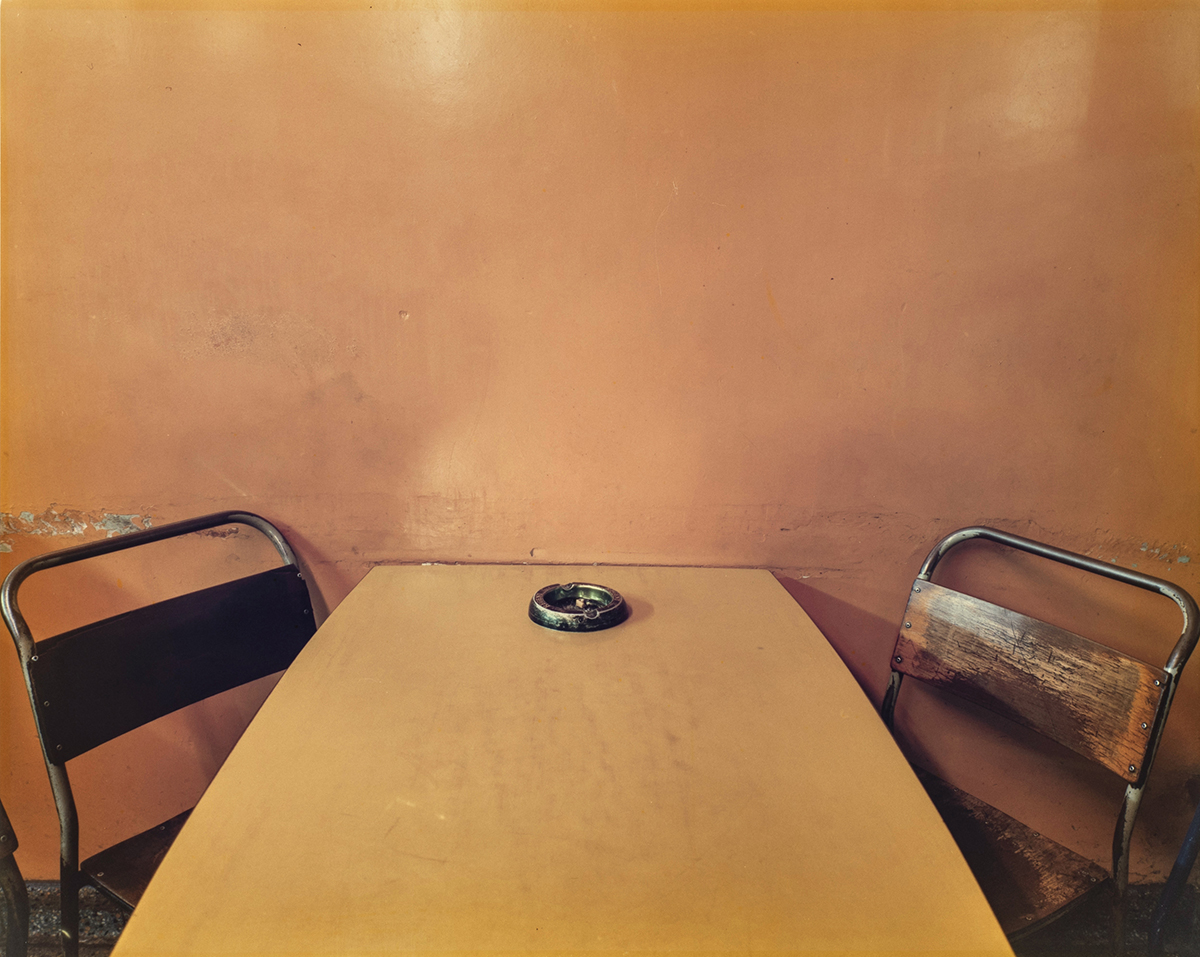These photographs, now four decades old, seem clearly stained with a sentiment for the country, or at least the country-of-my-mind.
Paul Graham

Little Chef in Rain, St. Neots, Cambridgeshire, May 1982
‘Memory is its own master. Perfect recall sadly does not exist for most of us. As we wind back through the years, our recollections become increasingly unreliable, with inconvenient facts erased, replaced, or reordered. Details come to the fore that were previously marginal, others recede on the ebb tide of time. Accepting of all of this, what would our lives amount to, if we did not at least try?
I was 25 when I started the A1 work, though I had been a photographer, of sorts, for a few years already. An unemployed one, yes, but equally one who didn’t want employment of the traditional kind. Or the photographic kind — I never understood those who wanted to be fashion photographers or take their direction from others. For me the struggle to create art from the world as-it-is was the highest calling of the medium, and where one should toil. Maybe that is naive or innocent, but things come of such youthful attributes — innocence minimises cynicism, naivety precludes conditioning. So, with my limited skills and modest knowledge of photographic history, I sought out some tableaux to work with, principally for itself, for what it was, but also to test myself against, to express devotion to the medium.
Politically, the late 1970s and early 1980s in the UK was the time of Margaret Thatcher, the right-wing Conservative Party leader, who was engaged in an economic war with the workers’ unions. She forced through the privatization of public housing and state industries like coal or steel, and set about dismantling and selling off everything not nailed down. Punk had burned so brightly, then flamed out. Anarchy had not come to the UK. It was clear the country was being pushed toward a new paradigm, rightfully or not, so a journey across its length, repeated many times, felt valid and timely.
The A1’s route was perfect as it was one of the foremost ‘A-road’ arteries of the nation: the Great North Road was designated number 1, the A1, which connected London, the nation’s capital, with the North, its industrial base, and on across the border to finish in Scotland. At the time I travelled, it ran from the Bank of England in London’s financial ‘City’ to the main Post Office in Edinburgh, Scotland’s capital. It had been rerouted many times from its original form, with ‘by-passes’ and A1(M) motorway upgrades, but retained echoes of key points from its historic past: coaching inns, the Comet Roundabout, toll bar restaurants, and Scotch Corner were among the many waymarkers that remain to this day.

Café Assistants, Compass Café, Colsterworth, Lincolnshire, November 1982. Paul Graham
Photographically, the A1 granted the freedom to photograph whatever and wherever — portraits, interiors, still life, landscapes, truck stops, transport bed-and-breakfasts, sunsets and grey skies, the wind moving hedgerows or rain-smeared forecourts — all and everything could be embraced along the way. My journeys were many, and mostly made in a Morris Mini Traveller car — the wooden-back estate version — which you could just about sleep in when necessary, as it often was. The car belonged to my partner’s grandmother and was kindly loaned to me, whenever needed. It got me up and down the road, surrounded by large haulage trucks, a tiny vehicle often in dreadful weather with minimal visibility, but protected by guardian angels, and the armour of youth.
I was working in colour, which was radical for the UK at that time, dominated as it was by black-and-white photography, and the entrenched hierarchy around that. Many who regarded A1’s images could not see beyond the use of colour, could not see the love and empathy for a changing country, or for photography itself. For them, the colour negated any other concerns, but time took care of all that.
As I traveled up and down the road, the question of when and where to photograph was left open to chance, to random encounter, though certain determinations were consciously made: not to photograph as though this was an American Road Trip, not to take images from a moving car window, not to use any stylisations like blur or filters. And positively, to embrace the grey skies — such as the Yorkshire windsock, the flooded fields, the Little Chef, or Highgate’s old Methodist Church. Britain is not blessed with blue skies and daily sunshine, yet the soft light has its unique qualities and tonality that one should respect. The famous English weather and its rain cycle created the land we pass through, the green fields, soft hills, streams, and verdant hedgerows — and to some degree shaped the lives we live, away from the elements for the most part.
The book is sequenced as a journey north, with the first image right beside the Bank of England, where on a crowded pavement, a lady pushes through in her blue coat and scarf, the political colours of Margaret Thatcher’s Conservative Party. Then, divine intervention, as the financial executive’s blue tie flips over his arm, reaching towards her blue coat. Un-posed, un-staged, direct from life. Clearly, as we begin our journey, we have the benediction of the gods. From London we travel up through the counties of Hertfordshire, Cambridgeshire, and Bedfordshire, where we meet Tony, who cleared cafe tables, with his crossword apron and huge smile; the transport cafe staff in Sandy or Grantham (hometown of Margaret Thatcher!) who were friendly and generous with their time and willing to be photographed by a twenty-five-year-old with a big wooden camera; the lorry drivers of the Midlands, beside their trucks, or in muddy parking lots, patient and accepting, even while ‘on-the-clock’. Magical moments arrive: fields on fire, Hopper-like glowing service stations, red poppies bursting through green crops, but then, so do interminable days of rain and featureless grey skies. Life without shadows.
The A1’s asphalt ribbon appears rarely — as glimpses beside hedgerows in Bedfordshire, or a foreground to North Sea views in Scotland, but most clearly by the Ferrybridge Power Station, with its cooling towers venting steam over the coal wagons on the bridge. Demolished in the 1990s, it sits resolutely here with the Jet and Esso petrol stations and a tarpaulin-wrapped lorry ploughing north, all markers of another era. Time took care not only of the A1’s mail coaches and ancient inns — giant power stations can be made to disappear too.
Finally up to the North, the by-pass sadly taking us around Newcastle-upon- Tyne, to the ‘Services’ rest stops, where a young couple on a day trip asked to be photographed together, with their bleached blond hair, and love bites (‘hickeys’) on their necks. Then across the border into Scotland, along a beautiful deserted stretch by the North Sea, to where the road finishes, in the heart of Edinburgh, and an old car showroom with illuminated signs promoting Humber and Singer cars, English marques long since demised.
It never occurred to me that the work was a marriage of the ‘British documentary tradition’ with ‘New Colour’, as a critic pointed out later, but you don’t always know what you are doing, while you are doing it. Still don’t — that is where the adventure lays for any artist. There is of course much more to these lives, images, locations than might appear, and so many unanswered questions — was the young Geordie man just out of the army? Is the lady at the bus stop ‘working’? What happened to the hotel that the sign in the Burning Fields advertises? And of course, where are these drivers, waitresses, and day trippers today?
These photographs, now four decades old, seem clearly stained with a sentiment for the country, or at least the country-of-my-mind. Then again, aren’t they all countries of our minds? Isn’t that the issue here? The lands we ‘live in’, their meaning and narratives are mostly a web we spin, stories we tell ourselves of history, identity, heritage, ‘character’ — these are the cloth in which we wrap ourselves, to explain or justify entrenched attitudes and political viewpoints. The history of those times, of punk and privatisation, are now as much a part of the Great North Road’s legacy as Highwaymen, or Romans, or defunct British car brands. Maybe this is how it had to be, though I prefer the fractal nature of chance, and its roiling path, to any notion of inevitability.
I live in New York City now, so likely there’s a wistfulness for Britain that stains my recollections. Or maybe it’s simply the wistfulness of age that comes to us all. I’m sure much was missed along the way, but you cannot be an intimate local for the length of an entire country. I swore I would live in beautiful Edinburgh one day, though that has yet to happen. ‘Never go back’ my father often used to say. He was guarding himself against disappointment, of things being lesser than he recalled, guarding against the pain of broken memories. Yet, these pebbles from forty years ago do not sting — they have love and empathy, they have gentleness in their clear-eyed vision. It is strange to see history arriving and taking away your children, but that is how it must be’
(By Paul Graham)
